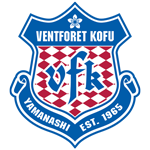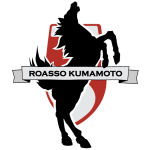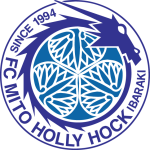| Coach | NA |
| Venue | Nippatsu Mitsuzawa Stadium |
Yokohama FC Trivia
Yokohama FC predictions
Predictions for Yokohama FC: See upcoming and historic predictions for Yokohama FC below.
Disclaimer: Past performance does not guarantee future results. Betting involves risk; only wager what you can afford to lose. Always gamble responsibly.
Yokohama FC Opinions
 Who is the most legendary player in Yokohama FC's history?
Who is the most legendary player in Yokohama FC's history?
Yokohama FC latest results
| 07/04 | - | ||
| 03/04 | 1 - 3 | ||
| 30/03 | 1 - 2 | ||
| 24/03 | 0 - 4 | ||
| 20/03 | 1 - 0 |
J2 League standings
| Rank | Team | MP | W | D | L | GF | GA | GD | Pts |
|---|---|---|---|---|---|---|---|---|---|
| 1 |
 Fagiano Okayama
Fagiano Okayama
|
7 | 5 | 2 | 0 | 9 | 2 | 7 | 17 |
| 2 |
 Shimizu S-pulse
Shimizu S-pulse
|
7 | 5 | 0 | 2 | 11 | 8 | 3 | 15 |
| 3 |
 Vegalta Sendai
Vegalta Sendai
|
7 | 3 | 4 | 0 | 6 | 3 | 3 | 13 |
| 4 |
 V-varen Nagasaki
V-varen Nagasaki
|
7 | 3 | 3 | 1 | 10 | 6 | 4 | 12 |
| 5 |
 Yokohama FC
Yokohama FC
|
7 | 3 | 2 | 2 | 9 | 4 | 5 | 11 |
| 6 |
 Ventforet Kofu
Ventforet Kofu
|
7 | 3 | 2 | 2 | 11 | 8 | 3 | 11 |
| 7 |
 Renofa Yamaguchi
Renofa Yamaguchi
|
7 | 3 | 2 | 2 | 8 | 5 | 3 | 11 |
| 8 |
 Ehime FC
Ehime FC
|
7 | 3 | 1 | 3 | 9 | 8 | 1 | 10 |
| 9 |
 Montedio Yamagata
Montedio Yamagata
|
7 | 3 | 1 | 3 | 8 | 7 | 1 | 10 |
| 10 |
 Blaublitz Akita
Blaublitz Akita
|
7 | 3 | 1 | 3 | 6 | 5 | 1 | 10 |
| 11 |
 Tochigi SC
Tochigi SC
|
7 | 3 | 1 | 3 | 7 | 12 | -5 | 10 |
| 12 |
 Iwaki
Iwaki
|
7 | 2 | 3 | 2 | 11 | 5 | 6 | 9 |
| 13 |
 Oita Trinita
Oita Trinita
|
7 | 2 | 3 | 2 | 6 | 5 | 1 | 9 |
| 14 |
 Kagoshima United
Kagoshima United
|
7 | 2 | 2 | 3 | 8 | 14 | -6 | 8 |
| 15 |
 Roasso Kumamoto
Roasso Kumamoto
|
7 | 2 | 2 | 3 | 7 | 13 | -6 | 8 |
| 16 |
 JEF United Chiba
JEF United Chiba
|
7 | 2 | 1 | 4 | 12 | 12 | 0 | 7 |
| 17 |
 Fujieda MYFC
Fujieda MYFC
|
7 | 2 | 1 | 4 | 3 | 10 | -7 | 7 |
| 18 |
 Mito Hollyhock
Mito Hollyhock
|
7 | 1 | 2 | 4 | 3 | 6 | -3 | 5 |
| 19 |
 Thespakusatsu Gunma
Thespakusatsu Gunma
|
7 | 1 | 2 | 4 | 5 | 9 | -4 | 5 |
| 20 |
 Tokushima Vortis
Tokushima Vortis
|
7 | 1 | 1 | 5 | 6 | 13 | -7 | 4 |
About Yokohama FC
Yokohama FC is a professional football club based in Yokohama, Japan. Established in 1999, it is renowned as the first club in Japan to be created by fans, following the merger of Yokohama Flügels and Yokohama Marinos. The merger led to the dissolution of Yokohama Flügels, which was a blow to its ardent supporters. In response, they rallied together to form Yokohama FC, a club that embodies the spirit of fan ownership and participation.
The club's history is a testament to the resilience and passion of its supporters. Despite starting in the Japan Football League, the third tier of Japanese football, Yokohama FC quickly ascended the ranks. In their debut season, they won the league and secured promotion to the J2 League, the second tier. The club's meteoric rise continued, and by 2000, they had reached the J1 League, the top tier of Japanese football.
Yokohama FC's journey has not been without its challenges. After their initial success, they faced relegation back to the J2 League. However, the club's supporters remained steadfast, and their loyalty was rewarded in 2019 when Yokohama FC once again secured promotion to the J1 League.
The club's emblem, a seagull soaring above the waves, symbolizes the spirit of Yokohama FC. It represents the club's determination to rise above adversity and its commitment to its fans and the city of Yokohama. The club's colors, blue and white, are a nod to its roots in Yokohama Flügels.
Yokohama FC has also been home to some notable players. The most famous is Kazuyoshi Miura, known as "King Kazu," who is recognized as one of Japan's greatest footballers. Even at over 50 years old, Miura continues to play for Yokohama FC, embodying the club's spirit of perseverance and passion.
Yokohama FC's home ground is the NHK Spring Mitsuzawa Football Stadium, also known as Mitsuzawa Stadium. With a capacity of just over 15,000, it may not be the largest stadium in Japan, but it is filled with a passionate and dedicated fan base that has been with the club through thick and thin.
In addition to its men's team, Yokohama FC also has a women's team and youth teams, reflecting its commitment to nurturing football talent at all levels. The club's philosophy is not just about winning matches but also about contributing to the local community and promoting the sport of football.
In summary, Yokohama FC is more than just a football club; it is a symbol of fan power and resilience. From its formation by dedicated supporters to its rise through the ranks of Japanese football, the club embodies the spirit of its city and its fans. Despite the challenges it has faced, Yokohama FC continues to soar, just like the seagull in its emblem.















